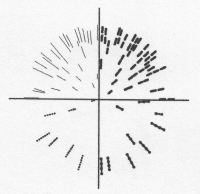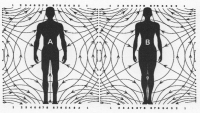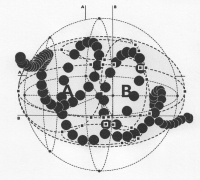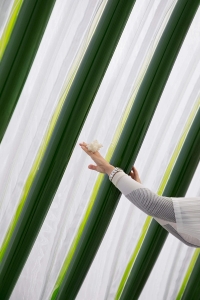SOMETHING AND NOTHING: THE DESIGN POTENTIAL OF AIR
Words by Riya Patel; Visuals by Arthur Teboul
Something and nothing: The design potential of air

Thinking about the potential of air requires viewing it as a something rather than a nothing. Culturally we regard it as having little substance or value. We talk about things ‘vanishing into thin air’ or someone being ‘full of hot air’ if they are talking nonsense. We know the air on Earth is made up of a mixture of nitrogen, oxygen and other gases that are vital to life, but it is, of course, invisible. Like much of nature, we take it for granted. Compared to other forms of matter it remains underdeveloped as a material or tool.
It has taken the major issue of urban pollution to make us more aware of air being a something. Particulate traces show themselves to city dwellers when they wash their skin and hair or clean their noses. Allergy sufferers can have intense reactions when their bodies detect toxins in the air or that the normal mix of gases is altered. Anyone having to live or work in an area of compromised air quality will know its life-limiting effects. Pollution is one way air makes itself visible and felt. The fields of science, politics and design are increasingly engaged with the issue of making our environments cleaner – that’s encouraging new questions about what we consider it to be.


Artists, architects and designers have commonly tackled the subject of air by making it visible, playing with its something-nothing status for experiential effect. Diller, Scofidio and Renfro’s Blur Building (2002) was an atmosphere of water vapour suspended above Switzerland’s Lake Neuchâtel; the mist created by pumping water through 35,000 fine nozzles. The cloud-like ‘building’ would change form naturally according to wind speed and direction. Jeppe Hein’s artwork Smoking Bench is from the same year. The viewer sits in front of a mirror while smoke emerges from the seat to temporarily shroud them, enclosing a personal space. Both used air as a medium to change the viewer’s relationship to and perception of the space around them.
Temperature was the method used for visitors to feel the air in the 2014 exhibition Hot and Cold by Fabrica. A group of tropical plants encased in ice slowly defrosted over the course of the exhibition as the air warmed up. Fans with blades of feathers moved by small gusts, reminding us of the importance of air currents to the flight and migration patterns of birds. Eight installations in all sought to represent aspects of air that are otherwise unnoticeable. For New Spring (2017), Studio Swine worked with the ability of air to carry scent. A tree-like fountain dispensed translucent bubbles to the audience. Each bubble spread a gentle aroma when it burst.
Thinking about the potential of air requires viewing it as a something rather than a nothing. Culturally we regard it as having little substance or value.

The feat of making air visible and tangible will continue to inspire moving artworks. An arguably harder task is to how to make air useful as a tool. Pneumatics is the established branch of engineering that uses compressed air as a force, but airflow could be a potential tool for moulding matter. Lars Dittrich’s Central Saint Martin’s graduate project Sculpting with Air investigates how to shape mycelium by growing it in a controlled chamber. It imagines a shoe of organic foam-like material sculpted into an exact fit dictated by airstreams rather than a physical mould. In industry, this method could be used to create and control products with a high level of customisation.
In the mid-1960s, inflatables were in vogue with radical architects who saw air as the method to create temporary structures suited to nomadic lifestyles. Cedric Price in 1964, proposed ideas for inflatable furniture and floors, publishing research through his Lightweight Enclosures Unit. Archigram proposed Instant City in 1968, a kit-of-parts settlement that could be moved around by airship. These brilliantly eccentric have been largely consigned to history, but they might again have relevance in times of climate emergency. As we seek non-extractive methods to build and make and use more products and structures only for the time they are needed, there is renewed interest in inflatables.


For London Fashion Week 2022, Alexander McQueen’s womenswear show was staged in a transparent bubble dome by Smiljan Radic, on a car park roof in Wapping. It was packed down, moved and reinflated the next year in a new location at Greenwich. Air Supply, an exhibition by students at Germany’s Muthesius University in 2022, showed ideas for inflatable products including suitcases, seats and lighting. Recycled plastic sheeting was CNC-welded to encase pockets of air for a range of applications that tested how stable and useful inflatable products could be.
Air is also proving its potential in the world of biotechnology. Our conversation with ecologic studio revealed its idea for air pollutants to be harvested and turned into products, food and material instead of just being disposed of. Rather than this happening on an industrial scale, the founders imagine a localised approach where people are empowered to manage, or ‘garden’ the air around them and use it as a resource. In Mitigation of Shock (2018), an imagining of a future apartment by Superflux, the residents grow their own mushrooms, cabbages, and chilli plants in stacks. Instead of soil, the plants are grown in a nutrient fog. Based on the principles of aeroponics and fogponics, this type of space-saving cultivation allows plants to absorb more nutrients, use less water and grow faster than they would in soil.
Ecologists and biotechnologists see air as a substantial something. A life-giving resource, not just an inert material to be forced into a pocket of space, or as vehicle to hold scent, vapour or temperature. It could be this view that gives designers their most profound relationship with air yet. When the Covid-19 pandemic swept the world, we understood on a personal level what it means for the air around us to potentially harm and compromise our lives. When we see risk our behaviour changes immediately. The invisibility of air and airborne diseases makes that a more difficult task. Right now, design is applying itself to the problem through filtration masks and purifying devices that capitalise on our fears about air quality. In the long term, it will be a better understanding of air and its potential that benefits us the most.